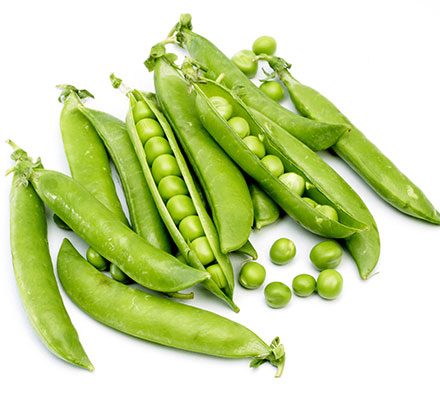
Why peas are good for your health: 7 benefits you should know
Green beans are rich in nutrients and can be used in many dishes. They can help control weight and diabetes.
Peas are small, round seeds that grow in the pods of the pea plant (Pisum sativum), a member of the legume family. They are usually green but can also be other colors, such as yellow. Peas are used in many foods around the world and can be eaten fresh, frozen or dried. Known for their sweet taste, this fruit is rich in nutrients such as protein, fiber, vitamins and minerals. These foods can help control blood sugar, manage weight and improve eye and heart health. Peas have many health benefits, so include them in your diet.
What are the health benefits of peas?
Peas are the best source of nutrition. According to the USDA, 100 grams of green peas contain the following components:
5.4 grams of protein
5.7 grams of fiber
25 mg calcium
1.47 mg iron
33 mg magnesium
244 mg potassium
40 mg vitamin C
38 mcg vitamin A
0.13 mg vitamin E
24.8 mcg vitamin K

Benefits of Peas
Peas are rich in nutrients. These nutrients contribute to overall health. Here are some reasons why peas are good for you:
1. Good for the gut
Peas are a good source of fiber, which aids digestion, prevents constipation and promotes bowel movements. The high fiber content also helps lower cholesterol. It reduces the absorption of cholesterol into the blood.
2. Rich in antioxidants
Peas contain polyphenols that may have antioxidant and anti-inflammatory properties, according to a study published in the British Journal of Nutrition in 2012. They also contain carotenoids and flavonoids which protects the body from the effects of oxidative stress and inflammation, often linked to chronic diseases like cancer.
3. Supports heart health
The combination of fiber, potassium, and antioxidants in peas may help prevent heart disease. “Potassium helps control blood pressure, while antioxidants such as flavonoids and carotenoids reduce oxidative stress, reducing the risk of heart disease,” experts say.
4. May Support Weight Management
According to the USDA, 100 grams of green beans contain 81 calories. Since peas are low in calories and high in protein and fiber, they can be a filling and beneficial food for weight control. The high fiber and protein content can help you feel full for longer, reducing your chances of overeating.
5. It can help promote eye health
According to the USDA, 100 grams of peas contain 2480 micrograms of lutein and zeaxanthin. These carotenoids are known to protect the eyes from damage caused by blue light and oxidative stress, thereby reducing the risk of age-related macular degeneration and cataracts.
6. May Help Control Blood Sugar
Peas are rich in protein, and according to a 2023 study published in the Journal of Obesity, consuming protein-rich foods may help control blood sugar in people with type 2 diabetes. It helps slow the absorption of sugar into the blood. “This makes them a good food option for controlling blood sugar, especially for people with diabetes,” experts said.
7. Ability to strengthen the body
Peas are rich in vitamins and antioxidants that support the immune system. The role of vitamin C in strengthening the immune system is known, but other nutrients such as vitamin A also help strengthen the immune system.
How to eat peas?
There are many ways to include peas in your diet!
1. Fresh or steamed
Fresh peas can be eaten raw or steamed to retain their nutritional value and increase their sweetness. They can be added to salads, pilafs or as a side dish.
2. Add peas to soups and stews
Peas add texture and flavor to soups and stews. Pea soup is a classic dish that showcases the flavor and nutritional value of green peas.
3. Add to stir-fries
Peas are a popular ingredient in stir-fries because they add a nice texture and sweetness. They pair well with many types of vegetables and meats.
4. Puree it!
Pureed peas can be used as a base for soups, sauces or as a garnish. It’s usually flavored with herbs, garlic and other spices.
5. Add to rice and pasta
Peas can be mixed into rice, such as bulao and fried rice. It can be combined with pasta, adding color and nutrition.
6. Eat as a snack
You can eat dried or roasted peas as a snack. They are usually seasoned with spices to add flavor. So when you are hungry in the middle of the day, eat peas instead of unhealthy snacks.

Are there any side effects of peas?
Peas can be eaten every day as part of a healthy diet. There is no specific limit to how much peas you should eat, but it is important to diversify your diet to ensure a variety of nutrients. “A large serving of peas is about half a cup (about 80 grams), which provides a lot of nutrients without a lot of calories,” experts say. Peas are a healthy food, but they also have side effects:
- Peas contain oligosaccharides, a type of carbohydrate that can be difficult for some people to digest and can cause gas and bloating.
- Peas are high in purines, which can stimulate uric acid production. For those with gout or kidney stones, eating large amounts of peas can increase the risk of an attack.
- In rare cases, some people may be allergic to peas and end up with itching and swelling.
Peas are versatile and nutritious, and they have many health benefits. They are easy to add to any dish. You can make them as a side dish, salad, soup or part of a main dish.
